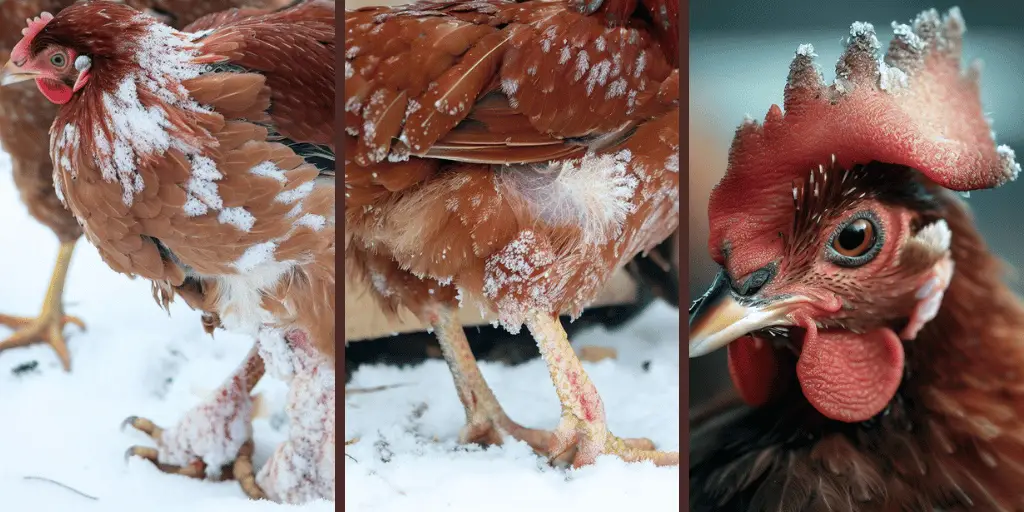
Do you want to know all about frostbite in chickens? How does it affect a chicken’s life and its treatment?
Frostbite is a common concern for chicken owners, especially in regions with cold climates. It occurs when the flesh and tissues of a chicken freeze due to exposure to freezing temperatures.
While chickens have natural defenses against the cold, such as their feathers, certain factors can increase their susceptibility to frostbite.
Understanding the causes, effects, treatment, and prevention methods for frostbite in chickens is essential for keeping your flock healthy and frostbite-free.
What is Frostbite in Chickens?
Frostbite in chickens occurs when extreme cold temperatures affect their body tissues, usually on their combs, wattles, toes, or other exposed areas.
When chickens are exposed to freezing conditions, the blood vessels in these areas can constrict, reducing blood flow and causing tissue damage. As a result, the affected parts may turn pale, dark, or black and become swollen or painful.
To prevent frostbite, provide shelter from cold winds, keep coop bedding dry, and offer warm water and nutritious food. Early detection and proper care are crucial to help affected chickens recover and avoid more severe complications.
What Does Frostbite Look Like on a Chicken?
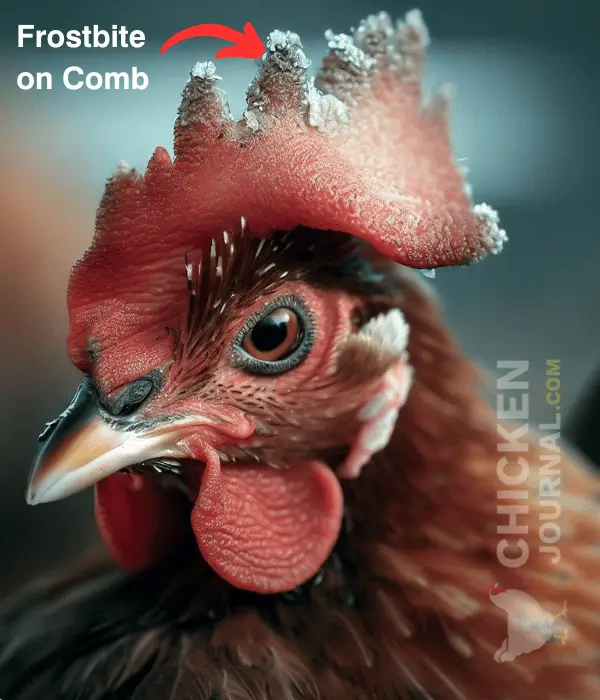
Frostbite in chickens typically impacts areas with less feather coverage, such as the comb, wattles, toes, and sometimes the tips of the comb feathers.
In the early stages, affected areas may appear pale and swollen. The skin and tissues can become dark or black as the condition progresses, indicating severe damage.
The frostbitten areas may feel cold, and the chicken might show discomfort or pain. Chickens suffering from frostbite may exhibit distress, reduced activity, or reluctance to move.
In severe cases, the affected tissues can become necrotic, leading to tissue death and the potential for secondary infections.
Causes of Frostbite in Chickens
Here are a few common causes of frostbite in chickens:
Cold Temperatures
Frostbite in chickens is primarily caused by exposure to freezing weather. Chickens are susceptible to frostbite when temperatures drop significantly, especially if exposed to the cold for extended periods without adequate protection.
When it’s cold, the body’s natural response is to conserve heat by constricting blood vessels, which reduces blood flow to the extremities, making them more vulnerable to freezing.
Lack of Feather Coverage
Chickens with large combs and wattles or those with sparse feathering in vulnerable areas are at a higher risk of frostbite.
Feathers provide insulation, trapping body heat and protecting the skin from freezing temperatures. When these areas are not well-covered, the exposed skin and tissues are more likely to freeze.
High Humidity
Cold and damp conditions can increase the risk of frostbite in chickens. High humidity in the coop or shelter can cause moisture to accumulate on the chicken’s skin or feathers. When this moisture freezes, it exacerbates the cold’s effects on the tissues, leading to frostbite.
Poor Ventilation
Inadequate ventilation in the coop or shelter can contribute to frostbite. When the air becomes stagnant and humid, moisture levels rise, increasing the likelihood of freezing. Additionally, cold drafts can intensify the chill, making frostbite more likely.
Inadequate Shelter
Chickens without access to proper shelter during cold spells are more susceptible to frostbite. A well-insulated coop with protection from wind and drafts helps maintain a stable and comfortable bird environment, reducing the risk of frostbite.
Dehydration
In winter, chickens may avoid drinking cold water, leading to dehydration. Dehydrated birds have reduced blood circulation, especially to their extremities, which increases the likelihood of frostbite.
Malnutrition
Inadequate nutrition weakens a chicken’s overall health and immune system, making them less resilient to extreme temperatures. Chickens that lack essential nutrients are more susceptible to frostbite and other health issues.
Also read: Best vitamins and minerals for chickens
Effects of Frostbite on Chicken’s Health
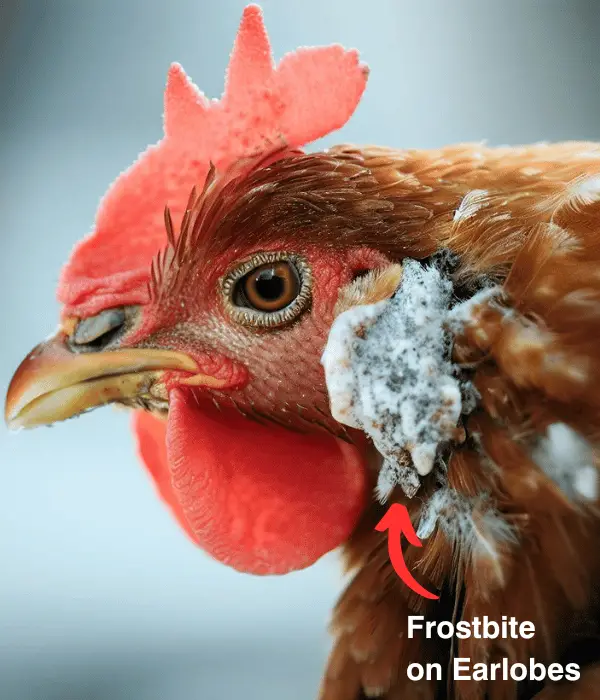
The joint effects of frostbite on flocks’ health:
Tissue Damage
Frostbite causes the chicken’s skin and underlying tissues to freeze, leading to cellular damage. Ice crystals can form in the cells, disrupting their structure and function.
This damage can be severe, especially in extreme cases, and may result in tissue necrosis (cell death).
Reduced Blood Flow
During frostbite, the blood vessels in the affected areas constrict to conserve heat, reducing blood flow to those regions.
This diminished blood supply means less oxygen and nutrients reach the tissues, hindering the body’s ability to repair and heal the damaged cells.
Pain and Discomfort
Frostbitten chickens often experience pain and discomfort. The affected areas may be sensitive, swollen, and tender.
This discomfort can cause the chicken to become lethargic and reluctant to move or eat.
Secondary Infections
Frostbite weakens the chicken’s immune system and damages the skin’s protective barrier, making it more susceptible to bacterial and fungal infections.
Open wounds from frostbite can quickly become infected, leading to further health complications.
Gangrene
In severe cases, frostbite can progress to gangrene, where the affected tissues die due to lack of blood flow and infection.
Gangrene poses a severe risk to the chicken’s health and may require veterinary intervention or amputation to prevent the spread of infection.
Impaired Mobility
Frostbitten feet and toes can be particularly problematic for chickens. If the tissues are severely damaged, the chicken’s ability to walk and perch may be impaired, affecting its overall mobility and quality of life.
Reduced Egg Production
Frostbite can adversely impact a hen’s reproductive system. The stress caused by frostbite may disrupt the hormonal balance, leading to a decrease in egg production or even temporary cessation.
Increased Vulnerability
Due to their weakened state, frostbitten chickens are generally more vulnerable to other health issues. They may be less capable of fighting off common infections, making them more susceptible to respiratory diseases and other illnesses.
Long-term Impact
In some cases, frostbite can cause lasting damage to the affected tissues, resulting in deformities, scarring, or altered growth patterns. These long-term effects can impact the chicken’s health and well-being.
Frostbite on Different Parts of a Chicken’s Body
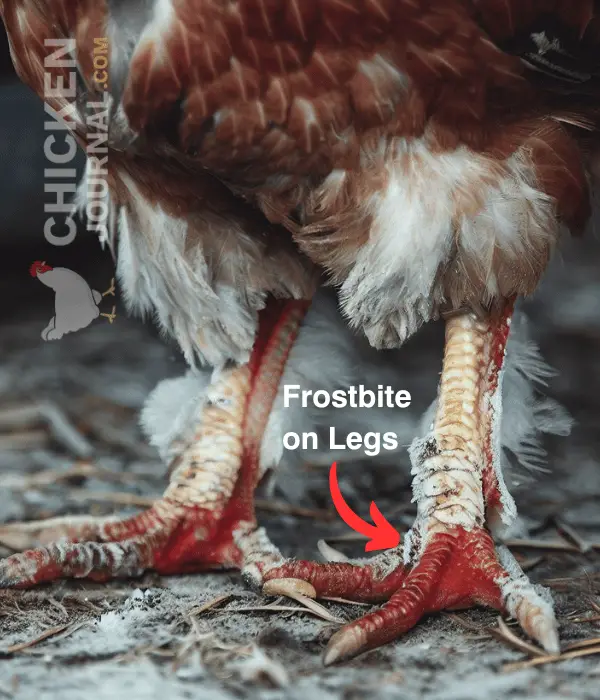
Frostbite can affect various parts of a chicken’s body, including the comb, wattles, feet, toes, legs, wings, breast, meat, head, and eyes.
Understanding how frostbite can impact these different areas is crucial for detection, treatment, and prevention.
Frostbite on Chicken Comb and Wattle
The comb and wattles are particularly susceptible to frostbite, especially in chickens with large combs. Due to their increased surface area, these fleshy, exposed areas are more prone to freezing.
Frostbite on the comb and wattles can range from mild discoloration to severe tissue damage. Monitoring these areas closely during cold weather and taking preventative measures to protect them is essential.
Frostbite on Chicken Feet, Toes, and Legs
Chickens’ feet, toes, and legs also risk frostbite. These extremities can suffer from frostbite when exposed to freezing temperatures and moisture.
The affected areas may appear discolored, swollen, and painful. Providing chickens with a dry and elevated surface is crucial to prevent their feet and toes from freezing.
Frostbite on Chicken Wings, Breast, and Meat
While less common, frostbite can also affect a chicken’s wings, breasts, and meat. These areas are less exposed but can still be affected in severe cold conditions.
Frostbite on the wings, breast, and meat can damage tissue and potentially lose of meat quality. Proper insulation and protection from freezing temperatures can help prevent such frostbite.
Frostbite on Chicken Head and Eyes
The head and eyes of chickens are relatively well-protected by their feathers. However, frostbite can still occur on the chicken’s head and around the eyes in icy conditions.
Monitoring for any signs of discoloration or swelling in these areas is essential to catch frostbite early and prevent further damage.
The Risk of Frostbite in Baby Chicks
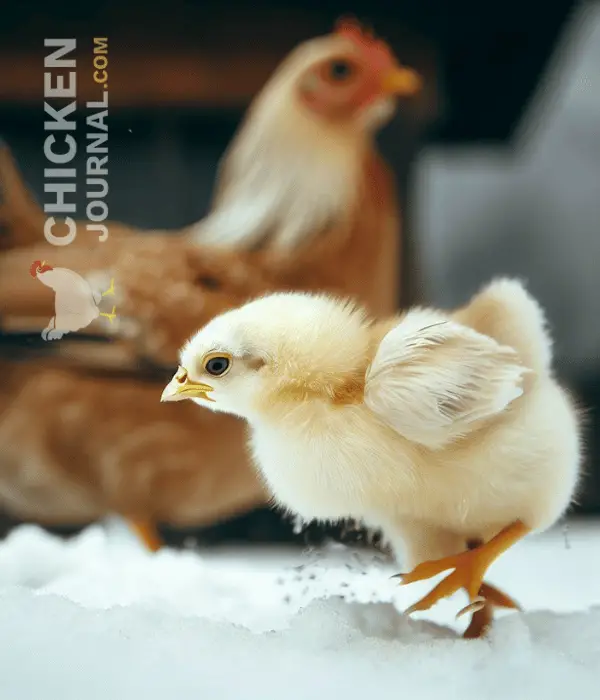
Baby chicks are more vulnerable to frostbite due to their underdeveloped feathers and less efficient temperature regulation.
Providing them with a warm and well-insulated brooder during cold weather is crucial. Extra care should be taken to ensure their living conditions are dry and draft-free to minimize the risk of frostbite.
How Temperature Influences Frostbite in Chickens?
Temperature plays a critical role in the development and severity of frostbite in chickens.
Frostbite occurs when body tissues freeze due to exposure to cold temperatures, and the degree of frostbite is directly influenced by how low the temperature drops and the duration of exposure.
Here’s how temperature influences frostbite in chickens:
1. Freezing Point of Tissues
Frostbite occurs when body tissues reach the freezing point. For chickens, the freezing point of tissues is around 32°F (0°C).
When the ambient temperature drops below this point, the tissues lose heat to the environment, especially in areas with less feather coverage, such as the comb, wattles, toes, and feet.
2. Duration of Exposure
The longer the chickens are exposed to cold temperatures, the greater the risk of frostbite. Prolonged exposure allows the cold to penetrate deeper into the tissues, increasing the potential for cellular damage.
3. Wind Chill Effect
Wind can accelerate the cooling of exposed body parts, known as the wind chill effect. Even if the ambient temperature is above freezing, strong winds can make it feel much colder to the chickens and intensify the risk of frostbite.
4. Moisture and Humidity
Moisture and humidity in the environment can contribute to frostbite. When moisture on the chicken’s skin or feathers freezes, it can exacerbate the cold’s effects, leading to frostbite.
5. Age and Health of Chickens
Young chicks, especially newly hatched ones, have less developed feathering and less ability to regulate their body temperature. They are more susceptible to frostbite than adult chickens.
Similarly, chickens in poor health or with weakened immune systems may be more vulnerable to frostbite due to reduced blood circulation and compromised tissue resilience.
6. Vulnerable Body Parts
Certain body parts of chickens are more susceptible to frostbite due to their exposure and lack of feather coverage.
The comb and wattles, being highly vascularized and projecting from the head, are particularly vulnerable. Chickens with large combs and wattles are at higher risk.
7. Preexisting Conditions
Chickens with existing injuries, frostbite, or other health issues may be more susceptible to frostbite in the affected areas, as the damaged tissues are more vulnerable to the cold.
Treatment Options for Frostbite in Chickens

As a poultry farmer, dealing with frostbite in chickens requires prompt action and careful management to ensure the affected birds’ well-being and prevent further complications.
Here’s a more detailed explanation of the treatment options and how to handle different types of frostbite
1. Early Detection
Regularly inspecting your chickens is essential, especially during cold weather. Pay close attention to combs, wattles, toes, and feet, as these are the most susceptible to frostbite.
Early detection allows you to start treatment promptly and can significantly improve the chances of recovery.
2. Move to a Warm Environment
If you identify any signs of frostbite, immediately move the affected chicken to a warm and dry environment. Provide extra bedding to ensure they stay dry and cozy.
A well-insulated coop with proper ventilation can help maintain a more stable temperature and prevent further exposure to cold.
3. Gentle Cleaning
Carefully clean the frostbite areas with a mild antiseptic solution or warm water. Remove any ice or debris from the affected skin to prevent additional damage. Avoid harsh chemicals or vigorous scrubbing, as the frostbitten tissues are delicate and easily injured.
4. Topical Ointments
Apply a soothing topical ointment like petroleum jelly or aloe vera gel to the frostbitten areas. These ointments form a protective barrier on the skin, helping to retain moisture and promote healing. They also provide some relief from discomfort and pain.
5. Pain Relief
If the chicken appears in pain or distress, consider providing pain relief medication suitable for poultry. Consult a veterinarian to ensure you administer the correct dosage and medication type.
6. Antibiotics
If the frostbite leads to open wounds or signs of infection, it is essential to consult a veterinarian.
They may prescribe appropriate antibiotics to prevent or treat infections. Infected frostbitten tissues can quickly deteriorate, leading to severe health issues if left untreated.
7. Wound Management
Proper wound management is crucial to prevent infection and support healing. Keep the frostbitten areas clean and dry, and regularly change the bedding to maintain cleanliness. If blisters are present, avoid breaking them to prevent infection.
8. Isolate the Affected Chicken
In cases of severe frostbite or if the chicken is pecked at by other birds in the flock, consider isolating the affected chicken. This reduces stress and gives the bird a better chance to recover without further injury.
9. Supportive Care
Provide the affected chicken with warm water and nutritious food. Proper nutrition is vital for supporting the immune system and aiding healing.
10. Veterinary Consultation
For severe or extensive frostbite, consult a veterinarian immediately. They can assess the situation, provide professional treatment recommendations, and offer wound care and management guidance.
In extreme cases, severe frostbite may require more advanced medical interventions or even amputation to prevent complications.
Prevention Methods for Frostbite in Chickens
Let’s delve into more details about each of the prevention methods for frostbite in chickens:
1. Provide Adequate Shelter
A well-insulated, draft-free coop protects chickens from frigid temperatures. The coop should be designed to minimize heat loss and keep the interior warm.
Proper insulation, such as thick walls and sealing gaps, helps retain heat, providing a comfortable environment for the chickens during colder periods.
2. Heat Source
A supplemental heat source like heat lamps or brooders is crucial, especially for baby chicks and chickens with large combs and wattles. Young chicks have underdeveloped feathering and cannot regulate their body temperature effectively.
Heat lamps provide a spot for them to huddle under and stay warm. Chickens with large combs and wattles are more prone to frostbite, so providing a heat source in the coop can help prevent freezing in these vulnerable areas.
3. Dry Bedding
Moisture and dampness in the coop can increase humidity levels, making chickens more susceptible to frostbite.
Wet bedding can also chill the birds’ feet and lead to discomfort. Regularly changing and cleaning the coop bedding keeps it dry, providing a more hygienic and comfortable environment for the chickens.
4. Ventilation Management
Proper ventilation in the coop is crucial to maintain good air quality and reduce humidity without creating cold drafts directly on the chickens.
Poorly ventilated coops can lead to condensation and moisture buildup, exacerbating frostbite risk.
Also read: Best chicken coop fans for ventilation
5. Roosting Bars
Roosting bars or platforms in the coop allow chickens to perch off the cold floor at night.
When chickens roost, their feet are tucked under their bodies, reducing the exposure of their feet to cold surfaces and minimizing the risk of frostbite.
6. Protect Combs and Wattles
- TRIPLE PURIFIED: Our Original Healing Jelly is made...
- FEEL THE PROTECTION: Our healing jelly is clinically...
- SOOTHING JELLY: Vaseline's petroleum skin protectant...
- DERMATOLOGIST RECOMMENDED: Our Healing Petroleum Jelly...
- ECZEMA RELIEF: Awarded the U.S. National Eczema...
Last update on 2024-07-14 / Affiliate links / Images from Amazon Product Advertising API
Chickens with large combs and wattles are particularly susceptible to frostbite. Protecting your chicken’s skin from direct contact with freezing temperatures is essential during freezing weather.
A protective barrier, such as petroleum jelly or a commercial balm, can help prevent frostbite.
7. Access to Warm Water
Offering warm water to the chickens during colder months helps maintain your chicken’s body temperature.
Cold water can cause a sudden drop in body heat, making the chickens more vulnerable to frostbite. Heated base poultry water is best for use in cold areas.
8. Nutritious Diet
A balanced and nutritious diet is vital for a chicken’s overall health and immune system. Proper nutrition helps them stay healthy and better equipped to handle colder temperatures and potential health challenges.
9. Monitor Weather Conditions
Stay informed about weather forecasts and be prepared for sudden temperature drops. When freezing weather is predicted, take extra precautions to protect the chickens from frostbite.
10. Regular Health Checks
Conduct regular health checks on your flock, especially during colder months. Look for signs of discomfort, such as huddling together excessively or reluctance to move.
Early detection of potential issues allows you to take prompt action and prevent frostbite from worsening.
11. Quarantine Sick Birds
If any chicken shows signs of frostbite or other health problems, isolate them from the rest of the flock.
Quarantining sick birds helps prevent the spread of illnesses and allows for focused care and attention to the affected chicken.
12. Promote Physical Activity
Encourage the chickens to move around and exercise during the day. Physical activity generates body heat, helping the chickens stay warm. Additionally, improved circulation supports overall health and reduces the risk of frostbite.
By implementing these prevention methods and paying close attention to the health and well-being of your flock, you can significantly reduce the risk of frostbite in chickens and create a comfortable and safe environment for them during colder weather.
Conclusion
Frostbite can pose significant risks to the health and well-being of your chickens. By understanding the causes, effects, treatment, and prevention methods for frostbite in chickens, you can take proactive measures to protect your flock.
You can keep your chickens healthy and frostbite-free throughout the winter by providing a dry and insulated living environment, monitoring for signs of frostbite, and taking prompt action when necessary.
Remember, prevention is critical, so prioritize the well-being of your flock by implementing appropriate measures to prevent frostbite.



Leave a Reply